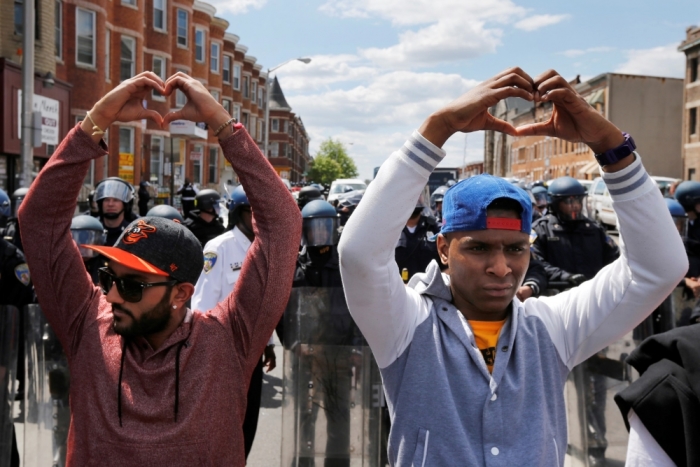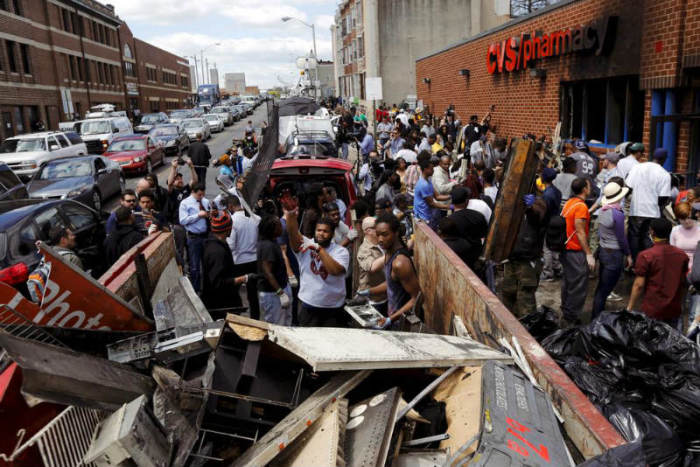Baltimore Pastor of Diverse Church Located Just Blocks From Rioting Says White Christians Need to Acknowledge Systemic Racism
Joel Kurz of The Garden Church in Central/West Baltimore Tells CP Causes Behind Protest, Rioting Are 'Complex'

The pastor of a youthful and racially-diverse congregation located just a few blocks from the CVS pharmacy set on fire by rioters amid otherwise peaceful protests in Baltimore says it's time for white Christians to acknowledge the existence of systemic racism in America and to listen to those who are angry and hurting in order to help find meaningful solutions.
"There are deep systemic issues. There is no surface issue that's really the cause. There's some deep stuff that's been going on that's been going on for a lot of years," Joel Kurz, lead pastor of The Garden Church in Central/West Baltimore, told The Christian Post on Wednesday.
Some of those "deep systemic issues" are believed to have been at play when Baltimore police officers chased and arrested Freddie Gray and placed him inside a van on April 12. Gray, who was arrested for having a switchblade-like knife in his possession, was admitted to a hospital less than two hours later, and was dead by the end of the week. The 25-year-old died at the University of Maryland's Shock Trauma Center where he had received surgery for his severely injured spinal cord and crushed voice box — injuries sustained while he was in police custody, according to The Baltimore Sun. Protesters had already taken to the streets the day before Gray's death, and when news of his passing came with no information on what might have befallen Gray during his arrest, their numbers swelled.

After days of peaceful protests, violence erupted. On Monday, April 27, some took to looting, targeting stores like a 7-Eleven and CVS in West Baltimore. Looters helped themselves to a variety of items — like toilet paper and napkins. In addition to looting stores, setting fires and destroying residents' and police vehicles, rioters had also targeted a $16 million low-income senior center run by a church. By the end of it all, 15 officers had been injured, nearly 202 people arrested, and 144 vehicles and 19 structures set on fire, according to CNN.
Citizens lining up to protect the police on W. North Ave. pic.twitter.com/Zt7nScM7lv
— Van Applegate (@VBagate) April 28, 2015The CVS pharmacy, a reportedly highly relied upon asset for the area's senior citizens, was in a state of ruin Tuesday when residents poured into the streets to clean up the mess caused by their neighbors, many of whom appeared to be youths based on photos and videos that captured the chaos. The violence was roundly condemned by the mayor, the police chief, and community leaders and residents — with many Baltimoreans turning out to ongoing protests with the specific intent to prevent troublemakers from disrupting the demonstrations with violence and therefore provoking police, many of whom were clad in riot gear.
Needless to say, the events unfolding in Baltimore have captured the nation's attention. Pastor Kurz, who helped plant The Garden Church in Baltimore seven years ago, cautioned outsiders and long-distance observers from taking a simplistic approach to what he believes is an otherwise complicated situation.
Some of Baltimore City's complexity is revealed among residents of Sandtown‐Winchester/Harlem Park in West Baltimore, to be where Gray lived. Baltimore's population of 620,961 people, 29 percent of whom are white and 64 percent are black, live in nine regions encompassing more than 200 neighborhoods.
In Gray's neighborhood, residents face "extraordinary challenges around educational attainment, housing, and addiction," according to statistics compiled by the Justice Policy Institute and the Prison Policy Initiative. The public policy think-tanks, both of which advocate for prison reform, report that 52 percent of the residents in Gray's neighborhood that are between the ages of 16-64 are unemployed, have a median household income of $24,000 (compared to $40,803 for the entire city), and have the third-highest incarceration rate among all of Baltimore. One out of every four people is on public assistance, more than double the general city average; 34 percent do not have a high school diploma or GED; and one out of every three houses is vacant or abandoned (based on 2012 findings).
For the 85,000 students in baltimore that are missing meals today #BaltimoreLunch volunteers are on the ground pic.twitter.com/uiLGoElsHd
— Carlene (@CMP4Justice) April 28, 2015Another startling statistic came to light Tuesday, when Baltimore City Public Schools kept schools closed as a safety precaution after the previous night's rioting. That decision affected nearly 85,000 students, 82.7 percent of whom are African-American, 8 percent white and 7.4 percent Hispanic/Latino. A whopping 84 percent of school children in Baltimore come from low-income households and qualify for free or reduced-meals. Activists and community members immediately sprung into action, organizing collections and distribution of food on Tuesday to make sure children's needs were met.
Pastor Kurz and some of his Garden Church members were also busy on Tuesday, preparing 200 lunches as part of the community-wide effort. "With everything going on it's very likely that kids were not eating throughout the day. We just wanted to make sure that before the day was over, kids, at least the few that we could get to in our own area right there, had the opportunity to eat something," Kurz told CP.
Kurz, who spoke via phone with CP on Wednesday, shared what he has learned from his neighbors, congregation members, and his own observations while living in Baltimore for the past seven years. In the interview, transcribed below, the Southern Baptist pastor also reveals his prayers for his city and some advice for Christians looking on and who may not be to sure what to make of the situation. The transcript has been lightly edited for clarity.
CP: How old is The Garden Church and what does its surrounding community look like?
Kurz: We've been here since 2008. We moved into the neighborhood ... we actually live in the neighborhood where the rioting took place. The CVS that burned, that's sort of like right on the edge of our neighborhood, it kinda borders our neighborhood. So that's where we're at. The neighborhood itself consists of predominantly generationally impoverished communities as well as working class mostly African-American males. At the same time though, we're only a few blocks from a very affluent neighborhood, the Maryland Institute of Cultural Arts (Maryland Institute College of Art) is there. So it's a very mixed area to some degree, at least within the close proximity of each other.
However, with that said though — this is partly why we actually moved here in 2008 — there's always been a lot of tension in this area, racial tension as well as economic ... economic tension actually more so than racial tension although unfortunately, that also looks like race as well.





























